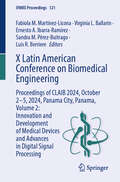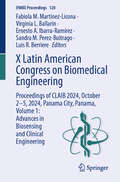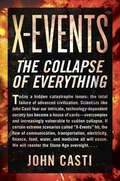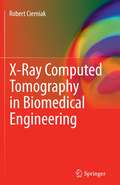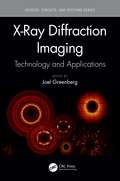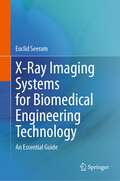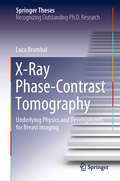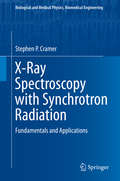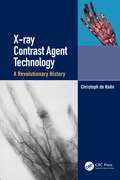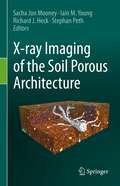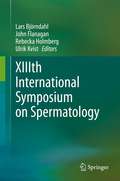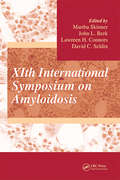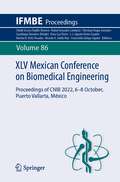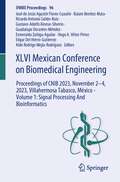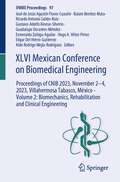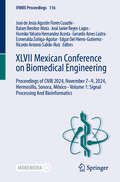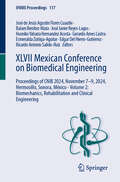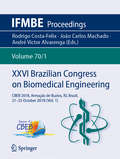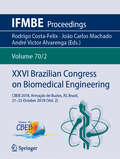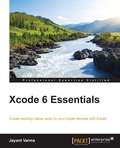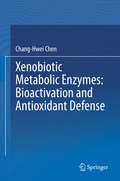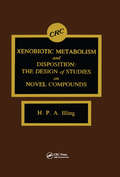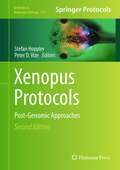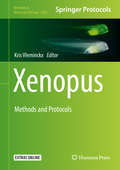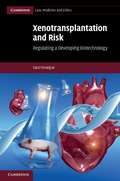- Table View
- List View
X Latin American Conference on Biomedical Engineering: Proceedings of CLAIB 2024, October 2-5, 2024, Panama City, Panama, Volume 2: Innovation and Development of Medical Devices and Advances in Digital Signal Processing (IFMBE Proceedings #121)
by Fabiola M. Martinez-Licona Virginia L. Ballarin Ernesto A. Ibarra-Ramírez Sandra M. Pérez-Buitrago Luis R. BerriereThis book reports on the latest research and developments in Biomedical Engineering, with a special emphasis on technologies transforming health in Latin America. This second volume of a 2-volume set covers advances in the development of assistive, therapeutic, and diagnostic devices, and cutting-edge methods for biological signal acquisition and analysis. Throughout the book, a special emphasis is given to low-cost affordable technologies and to their development for and applications in clinical settings. Based on the X Latin American Conference on Biomedical Engineering (CLAIB 2024) held on October 2-5, 2024, in Panama City, Panama, this book provides researchers and professionals in the biomedical engineering field with extensive information on new technologies and current challenges for their clinical applications.
X Latin American Congress on Biomedical Engineering: Proceedings of CLAIB 2024, October 2-5, 2024, Panama City, Panama, Volume 1: Advances in Biosensing and Clinical Engineering (IFMBE Proceedings #120)
by Fabiola M. Martinez-Licona Virginia L. Ballarin Ernesto A. Ibarra-Ramírez Luis R. Berriere Sandra M. Perez-BuitragoThis book reports on the latest research and developments in Biomedical Engineering, with a special emphasis on technologies transforming health in Latin America. This first volume of a 2-volume set covers advances in biosciences, robotics, biosensors and clinical engineering. Throughout the book, a special emphasis is given to low-cost affordable technologies and to their development for and applications in clinical settings. Based on the X Latin American Conference on Biomedical Engineering (CLAIB 2024) held on October 2-5, 2024, in Panama City, Panama, this book provides researchers and professionals in the biomedical engineering field with extensive information on new technologies and current challenges for their clinical applications.
X-Events: The Collapse of Everything
by John L. CastiA necessary and thought-provoking read for the age of coronavirus, exploring eleven scenarios that may trigger the collapse of the modern world — from pandemics to nuclear apocalypse to robot uprisings — and what we can do to prevent and survive them. In the twenty first century, our world has become impossibly complicated, relying on ever more advanced technology that is developing at an exponential rate. Yet it is a fact of mathematical life that higher and higher levels of complexity lead to systems that are increasingly fragile and susceptible to sudden, spectacular collapse.In this highly provocative and grippingly readable book, John Casti brilliantly argues that today’s advanced, overly complex societies have grown highly vulnerable to extreme events that will ultimately topple civilization like a house of cards. Like Nassim Taleb’s The Black Swan meets Jared Diamond’s Collapse, Casti’s book provides a much-needed wake-up call, sounding a fascinating and frightening warning about civilized society’s inability to recover from a global catastrophe.An eye-opening and necessary read, X-Events is a shocking look at a world teetering on the brink of collapse, and a population under constant threat from pandemic viruses, worldwide communication breakdowns, nuclear winter, or any number of unforeseeable “X-Events.” Fascinating and chilling, X-Events provides a provocative tour of the catastrophic outlier scenarios that could quickly send us crashing back to the preindustrial age – and shows that they may not be as far-fetched as they seem.
X-Ray Computed Tomography in Biomedical Engineering
by Robert CierniakComputed Tomography gives a detailed overview of various aspects of computed tomography. It discusses X-ray CT tomography from a historical point of view, the design and physical operating principles of computed tomography apparatus, the algorithms of image reconstruction and the quality assessment criteria of tomography scanners. Algorithms of image reconstruction from projections, a crucial problem in medical imaging, are considered in depth. The author gives descriptions of the reconstruction methods related to tomography scanners with a parallel X-ray beam, trough solutions with fan-shaped beam and successive modifications of spiral scanners. Computed Tomography contains a dedicated chapter for those readers who are interested in computer simulations based on studies of reconstruction algorithms. The information included in this chapter will enable readers to create a simulation environment in which virtual tomography projections can be obtained in all basic projection systems. This monograph is a valuable study on computed tomography that will be of interest to advanced students and researchers in the fields of biomedical engineering, medical electronics, computer science and medicine.
X-Ray Diffraction Imaging: Technology and Applications (Devices, Circuits, and Systems)
by Joel GreenbergThis book explores novel methods for implementing X-ray diffraction technology as an imaging modality, which have been made possible through recent breakthroughs in detector technology, computational power, and data processing algorithms. The ability to perform fast, spatially-resolved X-ray diffraction throughout the volume of a sample opens up entirely new possibilities in areas such as material analysis, cancer diagnosis, and explosive detection, thus offering the potential to revolutionize the fields of medical, security, and industrial imaging and detection. Featuring chapters written by an international selection of authors from both academia and industry, the book provides a comprehensive discussion of the underlying physics, architectures, and applications of X-ray diffraction imaging that is accessible and relevant to neophytes and experts alike. Teaches novel methods for X-ray diffraction imaging Comprehensive and self-contained discussion of the relevant physics, imaging techniques, system components, and data processing algorithms Features state-of-the-art work of international authors from both academia and industry. Includes practical applications in the medical, industrial, and security sectors
X-Ray Imaging Systems for Biomedical Engineering Technology: An Essential Guide
by Euclid SeeramThis book addresses X-Ray Imaging Systems intended for biomedical engineering technology students and practitioners, and deals with the major technical components of x-ray imaging modalities. These modalities include film-based imaging, digital radiography, and computed tomography. Furthermore, principles and concepts essential to the understanding of how these modalities function will be described. These include fundamental radiation physics, imaging informatics, quality control, and radiation protection considerations. X-Ray Imaging Systems for Biomedical Engineering Technology: An Essential Guide is intended for biomedical engineering technologists, who provide technical advice and services relating to digital radiography and CT departments not only in hospitals but in private facilities as well. Students in radiological technology programs may also find this to be a useful resource.
X-Ray Phase-Contrast Tomography: Underlying Physics and Developments for Breast Imaging (Springer Theses)
by Luca BrombalX-ray imaging is a corner stone of breast cancer diagnosis. By exploiting the phase shift of X-rays rather than their attenuation, phase-contrast tomography has the potential to dramatically increase the visibility of small and low contrast features, thus leading to better diagnosis. This thesis presents research on the first synchrotron-based project developing a clinical phase-contrast breast computed tomography (CT) setup at Elettra, the Italian Syncrotron Radiation Facility. This book includes a comprehensive theoretical background on propagation-based phase-contrast imaging, exploring and extending the most recent image formation models. Along with theory, many practical implementation and optimization issues, ranging from detector-specific processing to setup geometry, are tackled on the basis of a large number of experimental evidences. Most of the modelling results and data analysis have general validity, being a valuable framework for optimization of phase-contrast setups. Results obtained at synchrotron are also compared with "real world" laboratory sources: both a first-of-its-kind comparison with one of the few hospital breast CT systems and a state-of-the-art implementation of monochromatic phase-contrast micro-tomography with a conventional rotating anode source are presented. On a more general level, this work sheds a light on the importance of synchrotron-based clinical programs, which are key to trigger the long-anticipated transition of phase-contrast imaging from synchrotrons to hospitals.
X-Ray Spectroscopy with Synchrotron Radiation: Fundamentals and Applications (Biological and Medical Physics, Biomedical Engineering)
by Stephen P. CramerSynchrotron radiation has been a revolutionary and invaluable research tool for a wide range of scientists, including chemists, biologists, physicists, materials scientists, geophysicists. It has also found multidisciplinary applications with problems ranging from archeology through cultural heritage to paleontology. The subject of this book is x-ray spectroscopy using synchrotron radiation, and the target audience is both current and potential users of synchrotron facilities. The first half of the book introduces readers to the fundamentals of storage ring operations, the qualities of the synchrotron radiation produced, the x-ray optics required to transport this radiation, and the detectors used for measurements. The second half of the book describes the important spectroscopic techniques that use synchrotron x-rays, including chapters on x-ray absorption, x-ray fluorescence, resonant and non-resonant inelastic x-ray scattering, nuclear spectroscopies, and x-ray photoemission. A final chapter surveys the exciting developments of free electron laser sources, which promise a second revolution in x-ray science. Thanks to the detailed descriptions in the book, prospective users will be able to quickly begin working with these techniques. Experienced users will find useful summaries, key equations, and exhaustive references to key papers in the field, as well as outlines of the historical developments in the field. Along with plentiful illustrations, this work includes access to supplemental Mathematica notebooks, which can be used for some of the more complex calculations and as a teaching aid. This book should appeal to graduate students, postdoctoral researchers, and senior scientists alike.
X-ray Contrast Agent Technology: A Revolutionary History
by Christoph de HaenThis book documents the fascinating history of radiological techniques that use contrast agents. The text includes many of the fundamental documentary sources that bring to life the social and scientific background of the discoveries, the personalities of the discoverers, and implementation of new technologies. Such agents when used with X-rays allow clinicians to distinguish anatomical structures with nearly identical densities. Focus is on urological and angiographic uses of contrast agents. Key selling features: Documents and thoroughly references the history of contrast agent development Reviews the priority and importance of patents Discusses the role that important individual scientists and leading research institutions have played in technology development and implementation
X-ray Imaging of the Soil Porous Architecture
by Sacha Jon Mooney Iain M. Young Richard J. Heck Stephan PethThe advent of X-ray Computed Tomography (CT) as a tool for the soil sciences almost 40 years ago has revolutionised the field. Soil is the fragile, thin layer of material that exists above earth’s geological substrates upon which so much of life on earth depends. However a major limitation to our understanding of how soils behave and function is due to its complex, opaque structure that hinders our ability to assess its porous architecture without disturbance. X-ray imagery has facilitated the ability to truly observe soil as it exists in three dimensions and across contrasting spatial and temporal scales in the field in an undisturbed fashion. This book gives a comprehensive overview of the “state of the art” in a variety of application areas where this type of imaging is used, including soil water physics and hydrology, agronomic management of soils, and soil-plant-microbe interactions. It provides the necessary details for entry level readers in the crucial areas of sample preparation, scanner optimisation and image processing and analysis. Drawing on experts across the globe, from both academia and industry, the book covers the necessary “dos and don’ts”, but also offers insights into the future of both technology and science. The wider application of the book is provided by dedicated chapters on how the data from such imagery can be incorporated into models and how the technology can be interfaced with other relevant technical applications. The book ends with a future outlook from the four editors, each of whom has over 20 years of experience in the application of X-ray CT to soil science.
XIIIth International Symposium on Spermatology
by John Flanagan Lars Björndahl Ulrik Kvist Rebecka HolmbergThese proceedings of the 2018 XIII International Symposium on Spermatology focus on comparative biology, and encourages discussion and the exchange of ideas. The aim of this Symposium was to provide a unique opportunity and bring together scientists from a wide spectrum of research fields – human, domestic animals and other mammals, vertebrates, insects, and plants. The underlying focus is on the function of the spermatozoon – a common feature for sexual reproduction, but extremely varied. By exploring the variability, a better understanding of male reproductive functions can develop. These proceedings address the mechanisms of physiology and pathophysiology, rather than diagnosis and treatment. The symposium featured keynote lectures by invited speakers, followed by presentations on specific aspects of the general topic of the session. Experimental studies are given priority over clinical studies of patient populations. The proceedings comprise both keynote speakers' texts and selected free communications. Posters were considered for publication in the proceedings, and the volume includes exhibited materials on the work of prominent spermatologists, highlighting their important past achievements in the field.
XIth International Symposium on Amyloidosis
by Martha Skinner David C. Seldin John L. Berk Lawreen H. ConnorsEdited by a stellar team of scientists compiling more than 120 papers into a single tome, the XIth Annual International Symposium on Amyloidosis represents the most important review of the state-of-the-science and future directions of the field. An unparalleled cast of pioneering researchers, including keynote speaker and Nobel Laureate, Dr. Stanley Prusiner, present groundbreaking research in systemic amyloidosis including the mechanisms of disease and cellular toxicity, AA amyloidosis, familial amyloidosis, AL amyloidosis, clinical trials, and emerging translational approaches. Focusing on new basic and translational medicine approaches in systemic amyloidosis, this book provides clinicians and researchers with an invaluable reference to the most up-to-date research in the field.
XLV Mexican Conference on Biomedical Engineering: Proceedings of CNIB 2022, 6–8 October, Puerto Vallarta, México (IFMBE Proceedings #86)
by Dora-Luz Flores Citlalli Jessica Trujillo-Romero Rafael Gonzalez-Landaeta Christian Chapa-González Guadalupe Dorantes-Méndez J. J. Agustin Flores Cuautle Martha R. Ortiz-Posadas Ricardo A. Salido Ruiz Esmeralda Zuñiga-AguilarThis book reports on fundamental research, cutting-edge technologies and industrially-relevant applications in biomedical engineering. It covers methods for analysis, modeling and simulation of biological systems, reporting on the development and design of advanced biosensors, nanoparticles and wearable devices. It covers applications in disease monitoring and therapy, tissue engineering, sport and rehabilitation, and telehealth. It also reports on engineering methods for improving and monitoring medical service, and on advanced robotic applications. Gathering the proceedings of the XLV Congreso Nacional de Ingeniería Biomédica (CNIB2022), organised by the Mexican Society of Biomedical Engineering, this book offers a timely snapshot on technologies and methods in bioengineering, and on challenges related to their practical implementation in the health sector.
XLVI Mexican Conference on Biomedical Engineering: Proceedings of CNIB 2023, November 2–4, 2023, Villahermosa Tabasco, México - Volume 1: Signal Processing And Bioinformatics (IFMBE Proceedings #96)
by Guadalupe Dorantes-Méndez José de Jesús Agustín Flores Cuautle Balam Benítez-Mata Ricardo Antonio Salido-Ruiz Gustavo Adolfo Alonso-Silverio Esmeralda Zúñiga-Aguilar Hugo A. Vélez-Pérez Edgar Del Hierro-Gutiérrez Aldo Rodrigo Mejía-RodríguezThis book reports on cutting-edge research and best practices in the broad fiel of biomedical engineering. Based on the XLVI Mexican Congress on Biomedical Engineering, CNIB 2023, held on November 2-4, 2023 in Villahermosa Tabasco, Mexico, this first volume of the proceedings covers research topics in biomedical signals and image processing, artificial intelligence, biosensors, and wearable systems, with applications ranging from disease classification and diagnosis, to health monitoring and medical therapy. All in all, this book provides a timely snapshot on state-of-the-art achievements in biomedical engineering and current challenges in the field. It addresses both researchers and professionals, and it is expect to foster future collaborations between the two groups, as well as international collaborations..
XLVI Mexican Conference on Biomedical Engineering: Proceedings of CNIB 2023, November 2–4, 2023, Villahermosa Tabasco, México - Volume 2: Biomechanics, Rehabilitation and Clinical Engineering (IFMBE Proceedings #97)
by Guadalupe Dorantes-Méndez José de Jesús Agustín Flores Cuautle Balam Benítez-Mata Ricardo Antonio Salido-Ruiz Gustavo Adolfo Alonso-Silverio Esmeralda Zúñiga-Aguilar Hugo A. Vélez-Pérez Edgar Del Hierro-Gutiérrez Aldo Rodrigo Mejía-RodríguezThis book reports on cutting-edge research and best practices in the broad fiel of biomedical engineering. Based on the XLVI Mexican Congress on Biomedical Engineering, CNIB 2023, held on November 2-4, 2023 in Villahermosa Tabasco, Mexico, this second volume of the proceedings covers research topics in biomechanics, materials and engineering design and manufacturing, with applications in prostheses design and development, tissue engineering, medical device assessment and healthcare management. All in all, this book provides a timely snapshot on state-of-the-art achievements in biomedical engineering and current challenges in the field. It addresses both researchers and professionals, and it is expect to foster future collaborations between the two groups, as well as international collaborations. .
XLVII Mexican Conference on Biomedical Engineering: Proceedings of CNIB 2024, November 7–9, 2024, Hermosillo, Sonora, México - Volume 1: Signal Processing And Bioinformatics (IFMBE Proceedings #116)
by Esmeralda Zuñiga-Aguilar José de Jesús Agustín Flores Cuautle Balam Benítez-Mata Ricardo Antonio Salido-Ruiz José Javier Reyes-Lagos Humiko Yahaira Hernandez Acosta Gerardo Ames Lastra Edgar Del Hierro-GutierrezThis book reports on cutting-edge research and best practices in the broad field of biomedical engineering. Based on the XLVII Mexican Conference on Biomedical Engineering, CNIB 2024, held on November 7-9, 2024 in Hermosillo, Sonora, México, this first volume of the proceedings covers research topics in biomedical signal processing, computational biology and prosthetics, with applications of artificial intelligence for medical diagnosis, behavioral studies and more. All in all, this book provides a timely snapshot on state-of-the-art achievements in biomedical engineering and current challenges in the field. It addresses both researchers and professionals, and it is expected to foster future collaborations between the two groups, as well as international collaborations.
XLVII Mexican Conference on Biomedical Engineering: Proceedings of CNIB 2024, November 7–9, 2024, Hermosillo, Sonora, México - Volume 2: Biomechanics, Rehabilitation and Clinical Engineering (IFMBE Proceedings #117)
by Esmeralda Zuñiga-Aguilar José de Jesús Agustín Flores Cuautle Balam Benítez-Mata Ricardo Antonio Salido-Ruiz José Javier Reyes-Lagos Humiko Yahaira Hernandez Acosta Gerardo Ames Lastra Edgar Del Hierro-GutierrezThis book reports on cutting-edge research and best practices in the broad field of biomedical engineering. Based on the XLVII Mexican Conference on Biomedical Engineering, CNIB 2024, held on November 7-9, 2024 in Hermosillo, Sonora, México, this second volume of the proceedings covers research topics in biomechanics, materials and engineering design and manufacturing, with applications in prostheses design and development, tissue engineering, medical device assessment and healthcare management. All in all, this book provides a timely snapshot on state-of-the-art achievements in biomedical engineering and current challenges in the field. It addresses both researchers and professionals, and it is expected to foster future collaborations between the two groups, as well as international collaborations.
XXVI Brazilian Congress on Biomedical Engineering: CBEB 2018, Armação de Buzios, RJ, Brazil, 21-25 October 2018 (Vol. 1) (IFMBE Proceedings #70/1)
by Rodrigo Costa-Felix João Carlos Machado André Victor AlvarengaThis volume presents the proceedings of the Brazilian Congress on Biomedical Engineering (CBEB 2018). The conference was organised by the Brazilian Society on Biomedical Engineering (SBEB) and held in Armação de Buzios, Rio de Janeiro, Brazil from 21-25 October, 2018. Topics of the proceedings include these 11 tracks: • Bioengineering • Biomaterials, Tissue Engineering and Artificial Organs • Biomechanics and Rehabilitation • Biomedical Devices and Instrumentation • Biomedical Robotics, Assistive Technologies and Health Informatics • Clinical Engineering and Health Technology Assessment • Metrology, Standardization, Testing and Quality in Health • Biomedical Signal and Image Processing • Neural Engineering • Special Topics • Systems and Technologies for Therapy and Diagnosis
XXVI Brazilian Congress on Biomedical Engineering: CBEB 2018, Armação de Buzios, RJ, Brazil, 21-25 October 2018 (Vol. 2) (IFMBE Proceedings #70/2)
by Rodrigo Costa-Felix João Carlos Machado André Victor AlvarengaThis volume presents the proceedings of the Brazilian Congress on Biomedical Engineering (CBEB 2018). The conference was organised by the Brazilian Society on Biomedical Engineering (SBEB) and held in Armação de Buzios, Rio de Janeiro, Brazil from 21-25 October, 2018.Topics of the proceedings include these 11 tracks:• Bioengineering• Biomaterials, Tissue Engineering and Artificial Organs• Biomechanics and Rehabilitation• Biomedical Devices and Instrumentation• Biomedical Robotics, Assistive Technologies and Health Informatics• Clinical Engineering and Health Technology Assessment• Metrology, Standardization, Testing and Quality in Health• Biomedical Signal and Image Processing• Neural Engineering• Special Topics• Systems and Technologies for Therapy and Diagnosis
Xcode 6 Essentials
by Jayant VarmaThis book is aimed at developers who want to make applications for Apple devices with Xcode. iOS developers who have experience using other frameworks and languages can now migrate to Xcode and build creative, native apps.
Xenobiotic Metabolic Enzymes: Bioactivation And Antioxidant Defense
by Chang-Hwei ChenThis book provides a comprehensive, organized, and concise overview of xenobiotic metabolic enzymes and their health implications. The subjects addressed are broad in scope with an emphasis on recent advances in research on biochemical and biomedical aspects of these enzymes. The xenobiotics discussed include not just drugs, but also food, smoke, and other environmental chemicals. The subjects covered in this work include: metabolic enzymes and their catalyzed reactions, reactive intermediates generated from metabolic activation, oxidative stress mediated by electrophilic reactive intermediates, bioactivation - mediated cellular and functional damages, activation of Nrf2 – ARE pathway, genetic variations affecting metabolic enzyme expression, enzyme polymorphisms affecting xenobiotic - mediated toxicity, induction of metabolic enzymes for health benefits, and a diversity of metabolic enzyme modulators.
Xenobiotic Metabolism and Disposition: The Design of Studies on Novel Compounds
by Harry P.A. IllingThis publication explains the principles of the techniques used in disposition and metabolism studies in animals, in man, and in vitro. It includes methods for studying routes and rates of absorption, distribution, metabolism, and excretion of novel compounds and their metabolites. Relevant surgical, whole-body autoradiographic and pharmacokinetic procedures are discussed, together with techniques for separating and identifying metabolites and metabolic path-ways. Information on when the procedures are appropriate, and examples of what they represent, are presented in order to illustrate the value of such studies.
Xenopus Protocols
by Stefan Hoppler Peter D VizeDuring the 20th century Xenopus has flourished as an accessible experimental model system for studying vertebrate biology. The second edition of Xenopus Protocols:Post-Genomic Approaches expands upon the previous edition with novel approaches inspired by Xenopus tropicalis and the sequencing of its genome. Xenopus tropicalis genomics and tractable genetics combined with the unique experimental advantages of Xenopus laevis and their distinctive phylogenetic position make them unique model systems for vertebrate embryonic development in the 21st century. Written in the highly successful Methods in Molecular BiologyTM series format, chapters include introductions to their respective topics, lists of the necessary materials and reagents, step-by-step, readily reproducible laboratory protocols, and key tips on troubleshooting and avoiding known pitfalls. Authoritative and practical, Xenopus Protocols: Post-Genomic Approaches, Second Edition provides a toolkit that will enable every laboratory to maximize the power of this extraordinary experimental system in the post-genomic age.
Xenopus: Methods and Protocols (Methods in Molecular Biology #1865)
by Kris VleminckxThis volume explores techniques used to study and experiment with Xenopus in order to model or understand human disease. The chapters in this book cover topics such as implementation of CRISPR/Cas9 and TALEN in Xenopus from the design stage up to the genotyping stage; methods to explore generation of knock-in animals; cancer modelling and in vivo screening of congenital heart disease; electroporation; and phenotyping at the organismal level, cellular level, and proteome level. Written in the highly successful Methods in Molecular Biology series format, chapters include introductions to their respective topics, lists of the necessary materials and reagents, step-by-step, readily reproducible laboratory protocols, and tips on troubleshooting and avoiding known pitfalls.Cutting-edge and comprehensive, Xenopus: Methods and Protocols is a valuable resource for researchers who are interested in expanding their knowledge of this wide and developing field. This book will aid in keeping Xenopus at the forefront for biochemical, cell biological, and developmental studies and forward it as a preclinical disease model.
Xenotransplantation and Risk: Regulating a Developing Biotechnology
by Sara FovargueSome developing biotechnologies challenge accepted legal and ethical norms because of the risks they pose. Xenotransplantation (cross-species transplantation) may prolong life but may also harm the xeno-recipient and the public due to its potential to transmit infectious diseases. These trans-boundary diseases emphasise the global nature of advances in health care and highlight the difficulties of identifying, monitoring and regulating such risks and thereby protecting individual and public health. Xenotransplantation raises questions about how uncertainty and risk are understood and accepted, and exposes tensions between private benefit and public health. Where public health is at risk, a precautionary approach informed by the harm principle supports prioritising the latter, but the issues raised by genetically engineered solid organ xenotransplants have not, as yet, been sufficiently discussed. This must occur prior to their clinical introduction because of the necessary changes to accepted norms which are needed to appropriately safeguard individual and public health.
